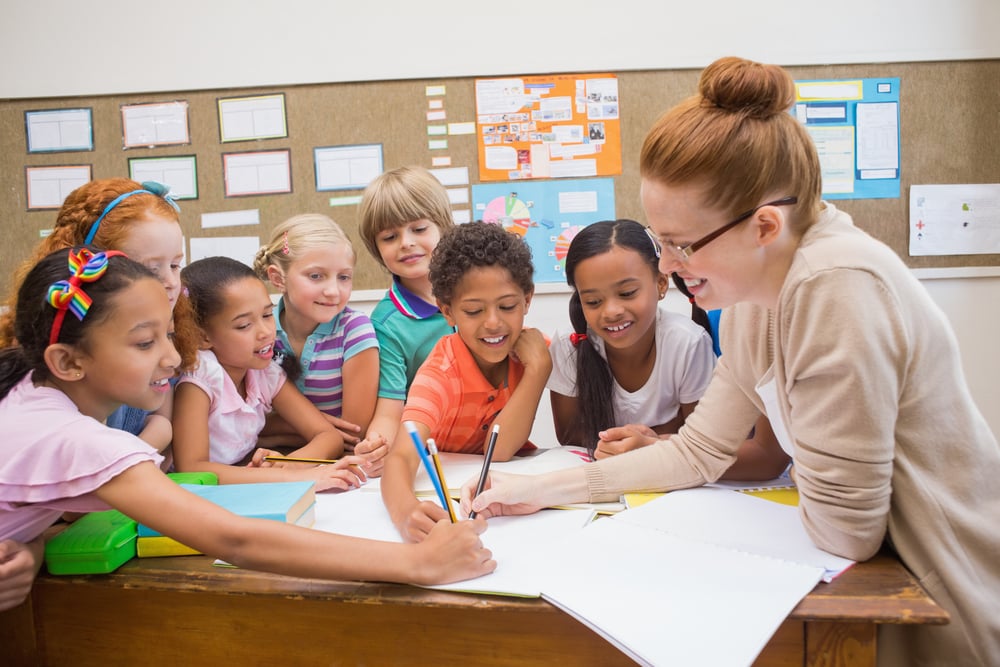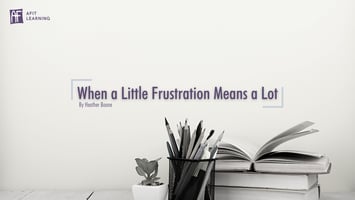When I was a child, I devoured books. I was a self-proclaimed bookworm who prided myself on my...
Effective Intervention for Struggling Students
Intervention is an increasingly common term in the world of education. To intervene as an educator, or as a whole school, means recognizing and addressing any gaps in a student’s progress, ideally as early as possible in that student’s educational journey.
In this article, we’ll consider why early intervention is beneficial—information that can be helpful for educators to share with parents who may resist accepting an intervention, especially if it means psychoeducational diagnoses will follow their child throughout their education.
We’ll also consider some strategies that you can adopt to help you plan the most effective interventions for your students; strategies that educators have told us not only benefit their students who are struggling, but their entire class as well.
Why Intervention?
Numerous studies emphasize the value of early intervention for students who are struggling academically or socially and emotionally. Researchers like Reynolds et al. (2001) note the benefits of higher educational achievement, lower drop-out and absenteeism rates, and lower rates of special education and of holding students back (i.e., grade retention). Hawkins et al. (2008) report that for the students they followed, “elementary grade intervention was related to greater accomplishment and engagement in school, work, and community, and fewer mental health problems by ages 24 and 27.”
Although the above examples focus on early intervention, intervention later in a child’s educational journey can likewise yield benefits. Krashen and McQuillan, 2007, for instance, point out the value of late intervention for struggling readers, if that intervention consists of “massive ‘free voluntary reading.’”
In general, however, when you consider the variety of negative impacts on students whose struggles are not recognized and addressed when they first start to appear (impacts such as extreme frustration, lack of engagement, problems with peers, lack of confidence, among others), it does not make sense to delay getting these students the help they so desperately need.
Knowing When to Intervene
Effective intervention begins with a clear identification of the need that exists. Often, the process starts with an observant educator or educational assistant noticing gaps in a student’s development and sharing their concerns with their school administration. Administration then reaches out to parents and families as well as other professionals engaged by families or working at the school, such as an occupational therapist, speech therapist, or school psychologist. Administration may also engage one of their specialized teachers or support teachers prior to a formal assessment. These specialized teachers can provide some supports and recommendations within the school setting if a child is experiencing challenges. However, a psychoeducational assessment may later be pursued as, through these assessments, families may find their child has an underlying learning disability, such as dyslexia or dyscalculia, or that their child has ADHD or anxiety, or some other condition that is making it difficult for them to positively experience learning and the school environment.
AFIT co-founder, Heather Boone, learned to her distress that getting a need or needs identified can be a long and difficult process that prevents children from getting help. In “When a Little Frustration Means a Lot” Heather describes her son’s increasing frustration with reading, despite the family being told there was nothing to worry about. Such was her son’s level of frustration, and the corresponding delay in assessment and intervention, that AFIT developed a learning app specifically designed to enable educators to assess frustration as a symptom of greater problems needing to be identified and addressed. As Heather realized through her own experience, assessment needs to be accurate and comprehensive so as to ensure early and effective intervention.

Types of Interventions
Once you have identified a need, the next step is to develop, in partnership with other professionals (for example, a pediatrician, psychologist, OT, etc.), a targeted intervention plan. Within the classroom setting there are a variety of interventions that can be implemented. For some students, individualized supports delivered through one-to-one engagement with a student (for example, in the form of a dedicated half- or full-day support person) may be necessary. However, a more universal approach through whole class intervention may also provide appropriate interventions. In some cases, it will be a mixture of both approaches. Often a whole school approach may also be appropriate, especially if the struggles some students are experiencing are commonplace across the school (for example, certain social-emotional issues, or math or literacy delays that occasion explicit instruction for all classes or small group learning sessions with a math or literacy specialist).
Alongside one-to-one and classroom-based interventions, Hannah Hawthorne at Hub (2021) identifies the following intervention types for use with struggling students:
-
Behavioural interventions
- In Canada, behaviour is often addressed through an individualized program plan (IPP), which sets out specific goals and steps to reach those goals. Students with behavioural issues may also benefit from medication and counselling, with counselling often being available through their school.
- In the Montessori classroom, students have access to a dedicated peace corner in their classroom for times when they are overwhelmed and experiencing difficulties self-regulating. In many schools, self-regulation techniques such as mindfulness, belly breathing, and yoga, are explicitly taught. Some schools employ the Zones of Regulation program to help students identify, understand, and regulate their emotions. Dramatic role play based on books about character development may also used to help students work through feelings and interactions that are experienced as complex and challenging.
-
Collaborative interventions
- While one-on-one support may be needed for some students, small group work that encourages structured and meaningful collaboration with peers can be helpful in guiding a struggling student to a deeper understanding of academic material through different entry points and methodologies, or by scaffolding important social skills development. A beneficial type of collaborative intervention can be achieved through consistent small project work. For example, two or three students may choose a topic and answer specific questions about it through image and text to later share with their peers as a class presentation.
-
Social, emotional, wellbeing interventions
- Social and emotional wellbeing develops when students feel that their classroom is a safe place to be. Educators can cultivate a sense of safety in their classroom through attention to the general environment (for example, uncluttered, neutral colours and design, calm lighting, soothing music, images from nature, student work on display) and through the tone they establish in their classrooms to encourage a quiet working environment of peaceful cooperation (for example, providing students with clear structure and an uninterrupted work period, agreed-upon classroom rules, and outlets for emotional and social exploration and wellbeing such as through the creative arts).
- As noted earlier, explicitly instructing on what emotional wellbeing looks like and using a program like the Zones of Regulation are helpful. Also helpful is the setting up of a wellbeing space for rest and regulation within the classroom.
-
Peer tutoring
- In many school environments today, opportunities are created for older students to mentor and support younger students, or for peers who have skills in certain areas, such as emotional regulation or a particular academic area, to work with a student who may be struggling in these areas. Between the ages of 6 and 12, students are especially focused on their peer group and creating opportunities for students to learn from one another enhances self-esteem as well as improvement in areas that require work and attention.
-
Metacognition and self-regulation
- As with social and emotional skills, metacognition can be explicitly taught. One of the best ways to intervene if a student needs to develop more self-awareness and metacognition is to engage in storytelling in two ways: 1) introduce books about emotional and social challenges that the entire class can relate to and learn from; and 2) to have students write about themselves and how they have managed or could manage particularly challenging situations that trigger a possible loss of control and strong feelings.
-
Homework
- Although there are a variety of ways to approach homework at different grade levels, for some students homework might consist of developmentally-appropriate reading books being sent home for parents to read with a struggling reader, or, if that struggling reader has dyslexia, the educator might introduce work material using a special font and provide speech-to-text software as well as more audio books in the classroom that may also be accessed by the student at home.
- As always, when supporting students, it is important for educators to do their own homework by establishing open lines of communication and partnership with families so that strategies effective at school can also translate into the home environment, and vice versa.
Successful Intervention
To successfully implement any type of intervention, it’s essential that you start with a solid understanding of the need to be met. If a full psychological-education assessment is not yet on the cards but you have concerns, consider an app like the Afit Learning app to help you establish if and how a particular student is struggling. Once you have a better idea of what’s going on, it’s then vital that you work with other teachers, your administration, associated professionals (if available), and student families to determine the right kind of intervention and to strategically plan how you are going to put that intervention into practice.
Remember that every student is different and the intervention that will work for one student will not work with another. Be creative in your approach and open to the process being fun and engaging for the students involved, rather than getting too focused on a rigid outcome. Also remember to listen if concerns are being raised by another teacher or by a parent about a student’s behaviour or progress. Adopting a 360 approach can ensure that student frustrations and struggles are not ignored but are examined and addressed as early and as effectively as possible.
Hannah Hawthorn recommends that educators implementing an intervention strive to make learning fun and link specific concepts and subject areas to the wider learning that is happening in the classroom for all students. She also notes that timing is key to an intervention and cautions that short, intermittent, personalized bursts of intervention may prove more effective than non-stop intervention that may isolate students and cause staff wellbeing to suffer.
Educators often learn most from their struggling students and most excel in their profession when they work to identify and meet those students’ needs. As many educators also already know from experience, effectively intervening on behalf of our struggling students benefits all of students. Don’t be afraid to dig deeper if a student is showing signs of frustration and difficulty in your classroom. You just might be on track to a successful intervention that will change that student’s educational experience and set them up for more positive experiences later in life.




